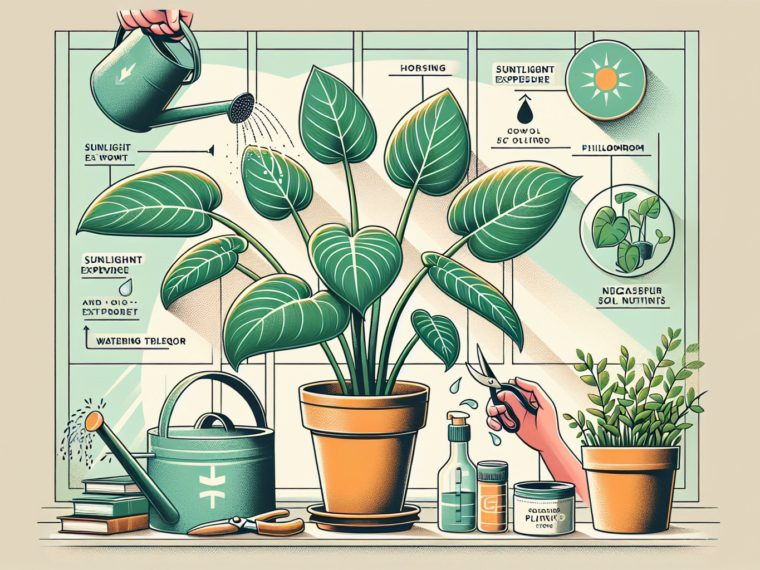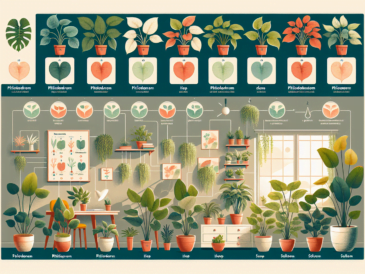A Glimpse at Philodendron Plants
Let’s start at the beginning. What’s a Philodendron? Part of the family Araceae or the arum family, Philodendrons are flowering plants that have taken root (pun intended) in homes, offices, landscapes – essentially anywhere they can bring a touch of greenery.
The Advantages of Indoor Philodendron Cultivation
People often raise an eyebrow at indoor plant rearing. Why would you bother? The answer is both straightforward and nuanced.
Growing Philodendrons indoors is a boon due to their charm, low maintenance requirements, and ability to purify the air, creating a healthier environment.
Rediscovering Philodendron Plants
Like people, Philodendrons come in many shapes, sizes, and types. Some are climbing types like the Heart leaf philodendron (Philodendron hederaceum var. oxycardium), while others are self-heading like the Lacy tree philodendron (Philodendron bipinnatifidum). There’s a Philodendron for every space.
Unique Characteristics of Philodendron Plants
Every plant has its unique quirks and identifiers, and Philodendrons are no different.
The leaves are glossy and vary in color from green to maroon and even shades of golden yellow. Then there’s the interesting bloom structure, featuring a spadix (a spike with tiny flowers) protected by a spathe – rather like a flower inside another leaf!
The First Steps with Philodendron Plants
With the sheer variety available, picking a Philodendron can be daunting.
But worry not! Start simply: consider your space space (is it small like an office cubicle or large like a mall?) and how much care you can provide.
Once done, plants-on, folks!
Essential Equipment for Philodendron Cultivation
Your plant parenting journey starts with the right tools. A sturdy container or basket, humidity-friendly soil (Miracle-Gro® Indoor Potting Mix works well), appropriate lighting, and a watering can – that’s all it takes.
Indoor Propagation of Philodendron
For indoor growth, Philodendrons prefer medium to bright indirect light and humid conditions. The temperature must hover between 65ºF and 80ºF – basically, comfortable room temperature.
The Importance of Position and Space
It’s not just about planting your Philodendron; it’s also about where you place it.
Whether as a tabletop plant or a hanging option, ensure there is enough room for the leaves and stems to grow without hindrance.
Taking Care of Your Philodendron
Ensuring the right amount of water and food isn’t limited to pets and kids; even Philodendrons need it. Water your plant when the top inch of soil is dry and use a balanced fertiliser every month for optimum plant health.
Light, Temperature and Soil Guidelines
Bright but indirect light, room temperature, and well-draining soil form the holy trinity of Philodendron care conditions. Failed to keep one in mind? There’s your reason your plant isn’t thriving.
Maintenance of Philodendron Plants
Pruning helps control plant size and encourage bushier growth. It also gives you segments for potential propagation. Repotting should be done every couple years as the plant outgrows its container.
Tackling Common Pests and Plant Diseases
Fungus gnats, aphids, even your cat – these are just some pests that could target your precious Philodendron. Watch out for any signs and tackle the issue head-on with suitable solutions.
Dealing with Philodendron Problem
Yellowing leaves?
Wilting plant? These are signs your Philodendron might be in distress. Identifying common problems early can help ensure your ‘green’ stays green!
Solutions for Common Problems
From over-watering to pest infestations to lack of light, there are many reasons why your Philodendron might be struggling. Don’t worry, though – with effective solutions like altering watering habits or moving the plant to a better-lit spot, you can save it!
Philodendron Pro Tips
Propagation refers to creating new plants using sections of an existing one.
With Philodendrons, this is usually done via stem cuttings planted in a soil or water medium.
Maximizing Philodendron Growth and Health
Some key tips to promote plant vibrancy and maximize growth include: regular watering schedules (without soaking the plant), supplementing with soluble industry-grade fertilizer and maintaining ideal light conditions need to be adhered to.
Conclusion
From understanding what a Philodendron is to knowing how to propagate it, we’ve covered quite some ground.
The journey from beginner Philodendron enthusiast to a seasoned owner has been both informative and rewarding.
Encouragement for Philodendron Success
Lastly, remember – when you bring a Philodendron into your surroundings, you’re not just adding greenery; you’re reducing toxin levels, increasing oxygen production, and generally creating a healthier indoor atmosphere. So keep growing!



